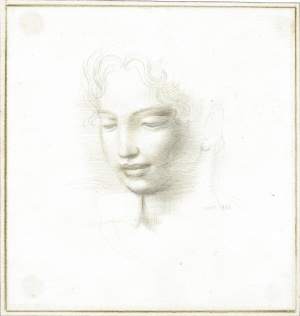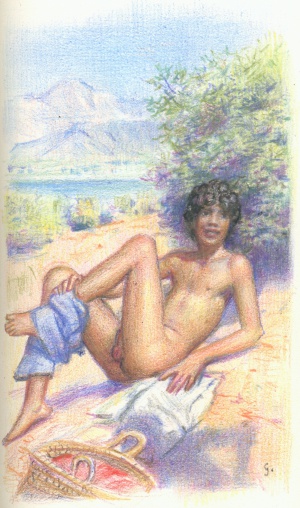Gaston Goor
Gaston Goor (1902-1977) was a highly accomplished and controversial painter of boys. His principal patron for more than 30 years has been Roger Peyrefitte. Goor illustrated many of Peyrefitte books and also made a number of works on various themes, many of which decorated the walls of Peyrefitte's Paris apartment. Goor's illustrations have also appeared in Montherlant's Diarium Juvenale.
https://fr.boywiki.org/wiki/Gaston_Goor
Illustrations pour des ouvrages particuliers :
→ Galerie des illustrations de Goor pour Les amitiés particulières
Biography
Gaston Marie Charles Leo Gibson was born in Lunéville on 26 October 1902. He was the son of Auguste Léon Goor and Marie Angèle Berthe Becker. At the age of seventeen, he entered the École des Beaux-Arts of Nancy where he continued his studies with poor attendance. In 1925, he left his native Lorraine and traveled to Paris to work in the studio of Amédée Ozenfant, founder with Le Corbusier of the movement called "purism" and the magazine L’Esprit Nouveau. He was introduced to modern art and met Picasso, Matisse, Lurçat, Max Jacob.
According to his own statements, it was a walk through Versailles that brings him back to the classical and away from the more theoretical advances in the field of art. It was through the André Salmon, he met André Gide who guides him towards the profession of Illustrator. Goor becomes almost the official illustrator of the Editions of Capitole, who publish André Gide, Léon Daudet (the journey of Shakespeare), Charles Maurras (three from tales of the Paradise Road), François Mauriac (God and Mammon, three great men before God), Pierre Mac Orlan. Léon Daudet (Le voyage de Shakespeare), Charles Maurras (Trois contes tirés du Chemin de Paradis), François Mauriac (Dieu et Mammon, Trois grands hommes devant Dieu), Pierre Mac Orlan. He was also the occasional illustrator of the Horizons de France editions, editions À l’Enseigne du Pot Cassé (he illustrated La religieuse de Diderot et L’ingénu de Voltaire) and Trianon (Restif de La Bretonne) editions.
He worked for the colonial exposition of 1929, and then created different work of Interior decoration for individuals. The paintings he paints, on the other hand, do not meet the desired success. He then embarks on a long study trip to Morocco and returned rather briefly to work for the Department of fine arts in 1933, and then moved to Hyères, where his family settled.

Dessin au crayon rehaussé de couleur, 19 × 18 cm
(frontispice pour Mon page de Renaud Icard)
It is through an array of 1.50 m., depictions of a young naked man, Jean Joerimann (featured below),that he connects with a fan, the writer and gallery owner Lyon Renaud Icard (1886-1971). Icard allows him to exhibit his works in Lyon, in his gallery,” L’Art Français” and a friendship developed between the two men. Gaston Goor graciously created the illustrations for Renaud Icard's book, “Mon page”, which will be published posthumously in 2009 by the Quintes-Feuilles editions. During this period of his life, Gibson is often called to do interior decoration on the behalf of wealthy clients and art lovers. Among these is the owner of Châteaubriant hotel, a large luxury hotel in the town of Hyères, who is the father of Jean Joerimann, the model for the illustrations of Mon page and for which Gibson is in love. The absence of reciprocity of this love causes him great anguish which his correspondences with Renaud Icard would latter recall.
Called up on by the famous architect Maurice Novarina (1907-2002) to decorate the Church of Douvaine in Haute-Savoie, Gibson moved to this area in 1942. His paintings were not limited to murals: he also liked to paint in the style of classical artists who were easily identifiable.
According to Peyrefitte, who collected his written testimony, it would be because Gaston Goor is accused by German police had helped the Jews to cross the Swiss border that he was forced to accept "voluntary worker" status in Germany. Gibson finds himself in the camp was near Zittau, in Saxony. Nevertheless, he is spotted for his talents, and is hired to the achievement of important works of art which, in February 1945, the destruction of the city of Dresden by Allied bombing put an end.
After the war, Gibson first returned to Paris, where he tried to work for the manufacture de Sèvres; then he moved to Cannes on the occasion of an exhibition. He contracted a marriage with a Polish émigré, Marie Angèle Zajackowski, in May 1947. Goor is then invited back to England by an architect of gardens to large sculptures. It is developing on this occasion a method of molding without metal frame. It was during his stay in England he is asked by editions Flammarion and Roger Peyrefitte to make illustrations of particular friendships which appear in 1953. This work marks a turning point in the life of Goor, who then returned to the France and settled in Paris. Roger Peyrefitte becomes for him a real patron, seeking to achieve a number of erotic works (as an illustration of the "Pergamon Ephebe" episode of the Satyricon), and presenting it to wealthy friends who pass to Goor many commands.
Less is known about the rest of the life of Gaston Goor, marked by some disappointments such as the non-publication of his illustrations for the Satyricon (not to be confused with those almost pornographic, of the only episode of the Ephebe of Pergamon).
Retired in Hyères, he died of cancer at the hospital in Toulon on December 13, 1977.
Sources
Roger Peyrefitte - the dell'innominato. New secret words. A. Michel, 1989. pp. 201-203.
Jean-Claude Féray - the history of my Page, his illustrations, and friendship Goor-Icard, in Renaud Icard - my Page. Fifths-leaves, 2009. pp. 157-195.
Correspondence Gaston Goor - Renaud Icard. (1932-1960) [Al (part.)
Gaston Gibson quotes
"On a fear to show that there is some pleasure to reproduce the life in that it was healthier, and that a water pot has the same value, emotionally, than a beautiful body, which is absurd." [Letter to Renaud Icard, Hyères, dated 7 October 1934.]
"Inside, I threw myself in art as others in the water. A suicide. "[Letter to Renaud Icard, Messery (Hte-Savoie) dated May 18, 1943].
A few works

Pastel, 16,8 × 9,9 cm (ill. pour L’oracle de Roger Peyrefitte)
Coll. privée
Most of the easily accessible Gaston Goor production consists of works of illustration for the edition. His paintings are almost all in private collections.
- 10 lithographs for the loves of Ovid, translation of Henri Bornecque, Paris, Flammarion (classics of love), 1953, 238 pp., 20 × 14 cm (edition limited to 4 000 ex.)
- 24 lithographs for particular friendships by Roger Peyrefitte, Paris, Flammarion, 1953, 2 vol., [4] - 180 p.-12 pl., [4] - 180 p.-12 pl., 29 × 20 cm (edition limited to 740 ex.)
- 32 illustrations in the book my Renaud Icard Page - Editions fifths-leaves, 2009-(ISBN 978-2953288513)
